Address: 519 Burnell Street
Architect: Thorstein Oddson
Contractor: Thorstein Oddson
Cost: $236,000
Opened: September 1914
Thelmo Mansions was designed and developed by Thorsteinn Oddson. He was an Icelandic immigrant, a carpenter by trade, who was responsible for most of the the residential developments on and around Burnell Street from Portage to Ellice Avenues.
Oddson's "triplets" on St. Paul Avenue
Oddson's specialty was small blocks or terraced housing with small living spaces. His portfolio already included Claremont Court, a development of small attached cottages near Ellice, (now demolished), and the 'triplets' Komoka, Kelona and Kolbrun on St. Paul Ave, all filled with 550 sq. ft. units. It was so important for him to get the most out of small spaces that he traveled to Seattle in April 1914 to meet a Mr. Holmes who had invented a new style of 'invisible bed', (a variation on the Murphy bed), for inclusion in his new blocks.
Construction began in early April 1914. Despite this being Oddson's largest project by far, work appears to have gone smoothly. It was advertizing its suite by early September and tenants began moving in soon after.
Thelmo Mansions contained 78 suites, ranging from two to five rooms. It was one of the biggest, one newspaper story claimed it was THE biggest, apartment block built in the city to that point.
Some of the first tenants were families that had to downsize due to the war. It appears that more than a dozen servicemen had connections to the building.
J.W. Nixon (source)
John William Nixon lived at unit 32 with his wife Kathleen when he enlisted in February 1916. He was killed on the front lines in France the following May.
James E. Tait (source)
James Edward Tait lived at suite 19, then 42, with his brother and wife Jesse when he enlisted in February 1916. He becme one of the city's most decorated soldiers, receiving the Military Cross and Victoria Cross. He was killed in action on August 11, 1918. Brother Richard returned home alive. (Read my extended post about Tait here.)
James Stephenson Fleming lived with his parents at Thelmo Mansions before going to school at University of Toronto to be a mining engineer. He was working his first job out of school near Timmins, Ontario when he enlisted. He was killed April 11, 1916.
Private John Scott of the 8th Battalion, Canadian Infantry was killed on May 19, 1915. He was 22 years old and left behind his parents at suite 19 Thelmo Mansions.
David F. Hamilton was wounded and missing for weeks before finally being reported as killed in action. He worked at Vulcan Iron Works and lived at suite 37 with his parents.
Soldiers returning from war
Harry Jarvis was reported as missing in action in September 1915 but survived to return to his wife Josephine in suite 67. Cavalryman Claude Cannon returned to his parents at suite 72. An injured M. G. Patterson came home to his wife in December 1915 with a paralyzed left leg. Reginald Hawkins also appears to have survived.
T. M. Sutherland was the son of Reverend T. M. Sutherland who was living at Thelmo Mansions while working in Winnipeg. His son left Sioux City, Iowa for Manitoba to work on a farm and eventually enlisted at the age of 16. While at Camp Bramshott in England, T. M. suffered major burns to his face and hands. After months of convalescing, he was returned to Winnipeg to live with his father.
Private Harry Lethbridge of the 8th Battalion was reported wounded and taken prisoner at Paderborn in July 1915. He spent six months in captivity in Germany before returning to Canada to recover. In April 1917 he married his girlfriend Annie Farr in a ceremony in suite 14. The couple spent the remainder of the war there.
October 6, 1917, Winnipeg Tribune
A financial casualty of the war was Thorstein Oddson. Winnipeg had been in a recession prior to its outbreak and the uncertainty of the war just made things worse. Thelmo Mansions was auctioned off on October 27th, 1917. (It appears that that First National Investment Co. in the Somerset Block on Portage Avenue bought it.)
No sooner had the war ended when another, related trouble came to Thelmo Mansions. Spanish Influenza was sweeping the world, brought back from the front by soldiers. In the end, it killed more people than the war did with estimates in the millions.
The flu arrived in Manitoba in October 1918. A Free Press article of November 21, 1918 notes that Thelmo Mansions was one of the worst effected places in the city with almost every one of the 78 units under quarantine. Officials blamed overcrowding in small suites.
The following day, Thelmo's caretaker called the paper to refute these claims, saying that only a handful of suites were under quarantine. An investigation found that the health nurses had, indeed, over-exaggerated the situation. There were just seven suites under quarantine and one death, an infant who was already ill with measles. (More on the Thelmo Mansions influenza situation can be found in Jones.)
The flu situation didn't scare off Bill Pulham. He and wife Margaret moved in during this time and stayed until 1940. You can see a history of the Pulhams here.
April 17, 1937, Winnipeg Tribune
The building was put up for sale again in 1937, there is no indication of who the new owner was. In 1938 permits were taken out for $1,000 in renovations, (about $15,000 in today's dollars.) The contractor was N. Popeski.
Empty Stocking fund ad, December 16, 1932
The Depression appears to have brought out the best of people at Thelmo Mansions.
In December 1932 a group of eight children from the building put on a show in the building's basement to raise money for the Winnipeg Tribune's Empty Stocking Fund. They collected $14 for the cause.
One resident that certainly needs mention is Eva Leadbetter of suite 27. At the beginning of the Depression the Salvation Army Adjutant created the Helping Hand League which collected donations of fabric, wool to make into quilts and clothing for poor families, especially single women with children. For a few years the headquarters for the organization was her apartment !
A volunteer base of up to 70 women and a dozen sewing machines produced and repaired thousands of items of clothing from this space that Leadbetter distributed on her bicycle. The League lasted into World War II but by that time had moved to larger premises. For more on Leadbetter and her helping Hand League check out this expanded post !)
November 13, 1942, Winnipeg Tribune
Eva ran summer camps for children and worked on the streets of the North End, sometimes staying over with families to take care of the sick or tend to neglected children.
In May 1942 the Winnipeg Tribune tells the story of Leadbetter walking into the Simonite Real Estate Agency with $200 that she saved from her Salvation Army stipend. She was seeking a home for an evicted family with eight children and wanted the agency to help find them a home. She offered to pay an additional $10 a month until the balance was paid off.

Where Barnett was nabbed then and now !
In February 1940 Thelmo Mansions had a chilling visit from John Barnett. He was one of three men involved in a botched downtown robbery that ended in the death of police Constable John McDonald. The group, whose ringleader was the infamous Mike "The Horse" Attamanchuk, fled the scene.
Police caught up with Barnett at Furby and Ellice and shot him in the ankle. He still led them on a 15-minute foot chase through the West End and into Thelmo Mansions. Police searched the building only to find his cap, jacket and some blood in the laundry room. He had escaped through a back door but was nabbed in the back lane.
September 14, 1943, Winnipeg Tribune
Another war meant another casualty. Private William G. Monk (above) of suite 35 was killed in 1943 and is buried in Germany.A number of others served but survived, including Captain W. J. Thomson (above), Training Officer Arthur Perceval, Sgt. Wallace A Swanson of suite 24, Eric Sinclair of suite 40 and Sgt. Stanley J. Child of suite 72 (see below).
Private Arthur Roland Quinn's parents lived at 43 Thelmo Mansions. He was listed as injured in action in December 1943 and in January 1944 was listed as having died from wounds. Thankfully, it was an error and Quinn did survive.
Another Thelmo Mansion resident, suite 50, was Trans-Canada Airlines pilot Andrew Madore. During the war, he established RCAF flight training schools at Prince Albert, Fort William and Virden, the latter considered the top of its kind in Canada. Madore, also a flight instructor, flew 7,047 hours with new recruits without a single incident. He was awarded the Air Force Cross by the Governor General in December 1942.
February 14, 1946, Winnipeg Free Press
It was a sweet reunion for the Stanley Child family on Valentine's Day 1946. His war bride and daughter Geraldine arrived from England at the C.P.R. station. The family initially settled into suite 72.
November 27, 1944, Winnipeg Free Press
Through to the 1970s the block had a fairly uneventful existence with no major crimes or fires noted in the newspapers. There were the usual dozens, if not hundreds of funeral and birth notices for residents. Many newlywed couples started out their married lives at Thelmo Mansions, there were even a few weddings held there !
In the 1930s the Gislasons, who ran the Delphi Tea Room on Portage Avenue, lived here. Above, Mr and Mrs. Fuinnur Johnson celebrated their 50th wedding anniversary in November 1944.
Over time, the condition of the building and quality of tenants declined. Its quiet existence came to an end in 1987 when Hazel Toye (60) was found dead in her suite. The following year a fellow tenant was charged with her murder. In 2004 another tenant, Stephanie Ann Buboire (30), was stabbed to death in what the Free Press referred to as a "rundown apartment building."
Later that year Thelmo Mansions stopped advertising suites for rent. In 2006 the building,owned by a numbered company headed by controversial developer Ray Rybachuk, was cited for a number of fire code violations and shut down.
It made the news in 2007 when a giant pile of garbage appeared in its parking lot which the city ordered cleaned up.
ca. Spring 2011
In 2009 a long, slow renovation project was underway, which included a bizarre reparging of the brickwork. The repair work appeared to get bogged down and in 2010 the vacant building suffered a $20,000 fire.
Related:
My Flickr album of Thelmo Mansions
Read the comments section at my original Thelmo post in 2011
In 2012 two U of W students did an oral history project about the block
More about Thorsteinn Oddson's West End
Some miscellaneous images from Thelmo Mansion's history:
Renovations ca. Feb. 2012 (courtesy V. King)
"Invisible bed" hideaway ca. Feb. 2012 (courtesy V. King)
"Invisible bed" hideaway ca. Feb. 2012 (courtesy V. King)
Mural in plaster found during renovations ca. Feb 2012 (courtesy V. King)







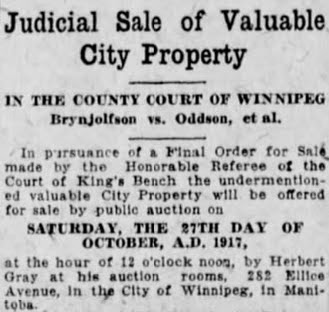











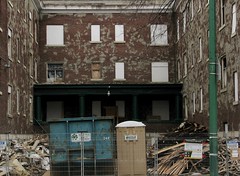
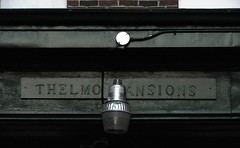



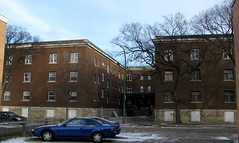
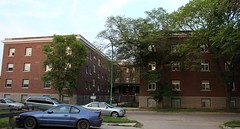



Hi I used to live in thelmo manstions before they ran it down basically, it was too bad it went bad, I don't know how it is now but I liked that building, being a person with a disability and struggling for employment it was affordable, 325 at the time. I had three different apartments there because bad tenants kept doing things like running the bathroom water so my ceiling caved in. I had to move out of the third apartment when I saw a mouse in my closet. I really liked it there, it was very close to foodfare where I did my grocery shopping. I'm still working but living in a worse area because I can't afford a decent place with no shopping nearby.
ReplyDeleteThis building is listed for sale, again. You can see photos (lots of the same 4/5 photos) on the realtor.ca site. I hope it is in good repair and finds a good buyer now.
ReplyDeleteHi I used to live there to at one time back in 1997-2000 , all I can say the memories of that shithole of a place I used live in suite 23
ReplyDelete